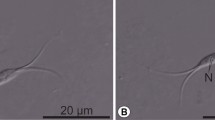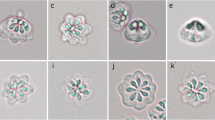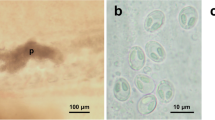Abstract
Myxosporean infection in marine water fishes has drawn less attention than in freshwater fishes, which resulted in a higher taxonomic variety in freshwater in Malaysia. This study aimed to address the gap by conducting a myxosporean survey on two commercially significant marine fish species, Nemipterus furcosus (Valenciennes) (Eupercaria incertae sedis: Nemipteridae) and Selar crumenophthalmus (Bloch) (Carangiformes: Carangidae), collected from the northeastern part of peninsular Malaysia. During the examination of the organs, two distinct Myxobolus Bütschli, 1882 species were discovered in the brain tissue of these fishes, despite the absence of any observable pathological signs. The two Myxobolus species were characterized through morphometry, morphology, and analysis of partial small subunit ribosomal RNA (18S rDNA) gene. As a result, Myxobolus acanthogobii Hoshina, 1952, which infects 2.3% of N. furcosus, is synonymous with a myxobolid species commonly found in Japanese waters, based on its morphological traits, tissue tropism, and molecular diagnostics. Furthermore, a novel species, Myxobolus selari n. sp., was described, infecting the brain of one (11%) individual S. crumenophthalmus. This unique species displayed distinctive features, placing it within a well-supported subclade primarily comprising brain-infecting myxobolids. Maximum likelihood analysis further revealed the close relationships among these brain-infecting myxobolids, underscoring the significance of tissue tropism and host taxonomy for myxobolids. This study represents the initial documentation of Myxobolus species within the southern South China Sea, shedding light on the potential diversity of marine myxosporean in this region. This article was registered in the Official Register of Zoological Nomenclature (ZooBank) as urn:lsid:zoobank.org:pub:7C400E35-7CB8-4DEE-92B7-F75FF3926441.



Similar content being viewed by others
Data availability
The research data will be made available upon request to ensure accessibility to our findings.
References
Abdel-Baki, A. A. S. (2011). Light and electron microscopic studies on Myxobolus egyptica sp. nov. (Myxozoa, Myxosporea), infecting the hornlip mullet Oedalechilus labiosus from the Red Sea. Acta Parasitologica, 56(3), 255–262. https://doi.org/10.2478/s11686-011-0053-7
Abdel-Baki, A. A. S., Sakran, T., Zayed, E., & Al-Quraishy, S. (2015). Re-description of Myxobolus fahmii from the gills of Barbus bynni with new data on the precise infection site, histological impacts, and seasonality. Parasitology Research, 114(6), 2047–2051. https://doi.org/10.1007/s00436-015-4387-1
Abràmoff, M. D., Magalhães, P. J., & Ram, S. J. (2004). Image processing with imageJ. Biophotonics International, 11(7), 36–41. https://doi.org/10.1201/9781420005615.ax4
Al-Nowfal, E. K. J., Khamees, N. R., & Al-Haroon, S. S. (2018). Occurrence of whirling disease symptoms in cultured common carp in Basrah, Iraq. Basrah Journal of Agricultural Sciences, 31(2), 76–81. https://doi.org/10.21276/basjas
Amira, F. S., Rahman, M. M., Kamaruzzaman, B. Y., Jalal, K. C. A., Hossain, M. Y., & Khan, N. S. (2016). Relative abundance and growth of male and female Nemipterus furcosus population. Sains Malaysiana, 45(1), 79–86.
Andree, K. B., Székely, C., Molnár, K., Gresoviac, S. J., & Hedrick, R. P. (1999). Relationship among members of the genus Myxobolus (Myxozoa: Bivalvidae) Based on Small Subunit Ribosomal DNA Sequences. Journal of Parasitology, 85(1), 68-74. https://doi.org/10.2307/3285702
Argente, A. F. T., Narido, C. I., Palla, H. P., & Celedonio, M. A. (2014). A review on the biology and parasites of the big-eye scad, Selar crumenophthalmus (Bloch, 1793). Journal of Multidisciplinary Scientific Research, 2(5), 3–8.
Arsan, E. L., Atkinson, S. D., Hallett, S. L., Meyers, T., & Bartholomew, J. L. (2007). Expanded geographical distribution of Myxobolus cerebralis: First detections from Alaska. Journal of Fish Diseases, 30(8), 483–491. https://doi.org/10.1111/j.1365-2761.2007.00834.x
Bahri, S., Karl, B., & Hedrick, R. P. (2003). Morphological and phylogenetic studies of marine Myxobolus spp. from mullet in Ichkeul Lake, Tunisia. The Journal of Eukaryotic Microbiology, 50(6), 463–470.
Banerjee, S., Patra, A., Adikesavalu, H., Mondal, A., & Abraham, T. J. (2015). The phylogenetic position of Myxobolus carnaticus (Myxozoa, Myxosporea, Bivalvulida) infecting gill lamellae of Cirrhinus mrigala (Hamilton, 1822) based on 18S rRNA sequence analysis. Molecular Biology Research Communications, 4(3), 125–132.
Barta, J. R., Martin, D. S., Liberator, P. A., Dashkevicz, M., Anderson, J. W., Feighner, S. D., Elbrecht, A., Perkins-Barrow, A., Jenkins, M. C., Danforth, H. D., Ruff, M. D., & Profous-Juchelka, H. (1997). Phylogenetic relationships among eight Eimeria species infecting domestic fowl inferred using complete small subunit ribosomal DNA sequences. The Journal of Parasitology, 83(2), 262–271. https://doi.org/10.2307/3284453
Bartošová, P., Freeman, M. A., Yokoyama, H., Caffara, M., & Fiala, I. (2011). Phylogenetic position of Sphaerospora testicularis and Latyspora scomberomori n. gen. n. sp. (Myxozoa) within the marine urinary clade. Parasitology, 138(3), 381–393. https://doi.org/10.1017/S0031182010001381
Borkhanuddin, M. H., Cech, G., Mazelan, S., Shaharom-Harrison, F., Molnár, K., & Székely, C. (2014). Myxobolus ophiocarae sp. n. (Myxozoa: Myxosporea: Bivalvulida) infecting the gill of wild goby, Ophiocara porocephala (Perciformes: Gobioidei) in Malaysia. Parasitology Research, 113(1), 29–37. https://doi.org/10.1007/s00436-013-3622-x
Borkhanuddin, M. H., Cech, G., Molnár, K., Shaharom-Harrison, F., Khoa, T. N. D., Samshuri, M. A., Mazelan, S., Atkinson, S. D., & Székely, C. (2020). Henneguya (Cnidaria: Myxosporea: Myxobolidae) infections of cultured barramundi, Lates calcarifer (Perciformes: Latidae) in an estuarine wetlands system of Malaysia: description of Henneguya setiuensis n. sp., Henneguya voronini n. sp. and Henneguya calcarifer n. sp. Parasitology Research, 119(1), 85–96. https://doi.org/10.1007/s00436-019-06541-1
Cech, G., Molnár, K., & Székely, C. (2012). Molecular genetic studies on morphologically indistinguishable Myxobolus spp. infecting cyprinid fishes, with the description of three new species, M. alvarezae sp. nov., M. sitjae sp. nov. and M. eirasianus sp. nov. Acta Parasitologica, 57(4), 354–366. https://doi.org/10.2478/s11686-012-0045-2
Chinh, N. N., Ha, N. T. H., Doanh, P. N., Eiras, J. C., Whipps, C. M., & Shirakashi, S. (2023). Synopsis of myxosporean species (Cnidaria: Myxozoa) parasitizing fishes from Vietnam. Systematic Parasitology, 100(4), 325–344. https://doi.org/10.1007/s11230-023-10090-8
Egusa, S., Maeno, Y., & Sorimachi, M. (1990). A new species of Myxozoa, Myxobolus episquamalis sp. nov. infecting the scales of the Mullet, Mugil cephalus L. Fish Pathology, 25(2), 87–91.
Eiras, J. C., Cruz, C. F., Saraiva, A., & Adriano, E. A. (2021). Synopsis of the species of Myxobolus (Cnidaria, Myxozoa, Myxosporea) described between 2014 and 2020. Folia Parasitologica, 68(012), 1–19. https://doi.org/10.14411/FP.2021.012
Eiras, J. C., Molnár, K., & Lu, Y. S. (2005). Synopsis of the species of Myxobolus Bütschli, 1882 (Myxozoa: Myxosporea: Myxobolidae). Systematic Parasitology, 61(1), 1–46. https://doi.org/10.1007/s11230-004-6343-9
Eiras, J. C., Zhang, J., & Molnár, K. (2014). Synopsis of the species of Myxobolus Bütschli, 1882 (Myxozoa: Myxosporea, Myxobolidae) described between 2005 and 2013. Systematic Parasitology, 88(1), 11–36. https://doi.org/10.1007/s11230-014-9484-5
Eszterbauer, E. (2004). Genetic relationship among gill-infecting Myxobolus species (Myxosporea) of cyprinids: Molecular evidence of importance of tissue-specificity. Diseases of Aquatic Organisms, 58(1), 35–40. https://doi.org/10.3354/dao058035
Eszterbauer, E., & Székely, C. (2004). Molecular phylogeny of the kidney-parasitic Sphaerospora renicola from common carp (Cyprinus carpio) and Sphaerospora sp. from goldfish (Carassius auratus auratus). Acta Veterinaria Hungarica, 52(4), 469–478. https://doi.org/10.1556/AVet.52.2004.4.9
Ferguson, J. A., Atkinson, S. D., Whipps, C. M., & Kent, M. L. (2008). Molecular and morphological analysis of Myxobolus spp. of salmonid fishes with the description of a new Myxobolus species. Journal of Parasitology, 94(6), 1322–1334. https://doi.org/10.1645/GE-1606.1
Fiala, I. (2006). The phylogeny of Myxosporea (Myxozoa) based on small subunit ribosomal RNA gene analysis. International Journal for Parasitology, 36(14), 1521–1534. https://doi.org/10.1016/j.ijpara.2006.06.016
Fiala, I., & Bartošová, P. (2010). History of myxozoan character evolution on the basis of rDNA and EF-2 data. BMC Evolutionary Biology, 10(228), 1–13. https://doi.org/10.1186/1471-2148-10-228
Fiala, I., Hlavničková, M., Kodádková, A., Freeman, M. A., Bartošová-Sojková, P., & Atkinson, S. D. (2015). Evolutionary origin of Ceratonova shasta and phylogeny of the marine myxosporean lineage. Molecular Phylogenetics and Evolution, 86(March), 75–89. https://doi.org/10.1016/j.ympev.2015.03.004
Forró, B., & Eszterbauer, E. (2016). Correlation between host specificity and genetic diversity for the muscle-dwelling fish parasite Myxobolus pseudodispar: Examples of myxozoan host-shift? Folia Parasitologica, 63(April), 1–8. https://doi.org/10.14411/fp.2016.019
Freeman, M. A., & Kristmundsson, Á. (2015). Histozoic myxosporeans infecting the stomach wall of elopiform fishes represent a novel lineage, the Gastromyxidae. Parasites and Vectors, 8(1), 1–13. https://doi.org/10.1186/s13071-015-1140-7
Gilbert, M. A., & Granath, W. O. (2003). Whirling disease of salmonid fish: life cycle, biology, and disease. The Journal of Parasitology, 89(4), 658–667. https://doi.org/10.1645/GE-82R
Gupta, A., & Kaur, H. (2017). A new pathogen, Myxobolus holzerae (Myxosporea: Myxozoa) causing severe gill disease in an Indian major carp Labeo rohita in a cold water wetland, Punjab (India). Microbial Pathogenesis, 111, 244–251. https://doi.org/10.1016/j.micpath.2017.08.044
Hall, T., Biosciences, I., & Carlsbad, C. (2011). BioEdit: an important software for molecular biology. GERF Bulletin of Biosciences, 2(1), 60–61.
Hallett, S. L., & Diamant, A. (2001). Ultrastructure and small-subunit ribosomal DNA sequence of Henneguya lesteri n. sp. (Myxosporea), a parasite of sand whiting Sillago analis (Sillaginidae) from the coast of Queensland, Australia. Diseases of Aquatic Organisms, 46(3), 197–212. https://doi.org/10.3354/dao046197
Heiniger, H., & Adlard, R. D. (2013). Molecular identification of cryptic species of Ceratomyxa Thélohan, 1892 (Myxosporea: Bivalvulida) including the description of eight novel species from apogonid fishes (Perciformes: Apogonidae) from Australian waters. Acta Parasitologica, 58(3), 342–360. https://doi.org/10.2478/s11686-013-0149-3
James, C. T., Veillard, M. F., Martens, A. M., Pila, E. A., Turnbull, A., Hanington, P., Luek, A., Alexander, J., & Nehring, R. B. (2021). Whirling disease in the crowsnest river: An emerging threat to wild salmonids in Alberta. Canadian Journal of Fisheries and Aquatic Sciences, 78(12), 1855–1868. https://doi.org/10.1139/cjfas-2020-0484
Karlsbakk, E., Kristmundsson, Á., Albano, M., Brown, P., & Freeman, M. A. (2017). Redescription and phylogenetic position of Myxobolus ‘eglefini’ and Myxobolus platessae n. comb. (Myxosporea), parasites in the cartilage of some North Atlantic marine fishes, with notes on the phylogeny and classification of the Platysporina. Parasitology International, 66(1), 952–959. https://doi.org/10.1016/j.parint.2016.10.014
Kaur, H., & Singh, R. (2012). A synopsis of the species of Myxobolus Bütschli, 1882 (Myxozoa: Bivalvulida) parasitising Indian fishes and a revised dichotomous key to myxosporean genera. Systematic Parasitology, 81(1), 17–37. https://doi.org/10.1007/s11230-011-9321-z
Ksepka, S. P., Rash, J. M., Simcox, B. L., Besler, D. A., Dutton, H. R., Warren, M. B., & Bullard, S. A. (2020). An updated geographic distribution of Myxobolus cerebralis (Hofer, 1903) (Bivalvulida: Myxobolidae) and the first diagnosed case of whirling disease in wild-caught trout in the south-eastern United States. Journal of Fish Diseases, 43(7), 813–820. https://doi.org/10.1111/jfd.13183
Kumar, S., Stecher, G., & Tamura, K. (2016). MEGA7: Molecular Evolutionary Genetics Analysis Version 7.0 for Bigger Datasets. Molecular Biology and Evolution, 33(7), 1870–1874. https://doi.org/10.1093/molbev/msw054
Liu, Y., Lövy, A., Gu, Z., & Fiala, I. (2019). Phylogeny of Myxobolidae (Myxozoa) and the evolution of myxospore appendages in the Myxobolus clade. International Journal for Parasitology, 49(7), 523–530. https://doi.org/10.1016/j.ijpara.2019.02.009
Lom, J., & Arthur, J. R. (1989). A guideline for the preparation of species descriptions in Myxosporea. Journal of Fish Diseases, 12(2), 151–156. https://doi.org/10.1111/j.1365-2761.1989.tb00287.x
Lom, J., & Dyková, I. (2006). Myxozoan genera: Definition and notes on taxonomy, life-cycle terminology and pathogenic species. Folia Parasitologica, 53(1), 1–36. https://doi.org/10.14411/fp.2006.001
Lom, J., Pike, A. W., & Dyková, I. (1991). Myxobolus sandrae Reuss, 1906, the agent of vertebral column deformities of perch Perca fluviatilis in northeast Scotland. Diseases of Aquatic Organisms, 12, 49–53. https://doi.org/10.3354/dao012049
Lovy, J., & Hutcheson, J. M. (2016). Myxobolus mauriensis n. sp. infecting rib cartilage of young-of-the-year river herring in New Jersey: Notes on pathology, prevalence, and genetics. Journal of Parasitology, 102(4), 419–428. https://doi.org/10.1645/15-939
Marcotegui, P., & Martorelli, S. (2017). Myxobolus saladensis sp. nov., a new species of gill parasite of Mugil liza (Osteichthyes, mugilidae) from Samborombón Bay, Buenos Aires, Argentina. Iheringia - Série Zoologia, 107(August), e2017026. https://doi.org/10.1590/1678-4766E2017026
Matsunuma, M., Motomura, H., Matsuura, K., Shazili, N. A. M., & Ambak, M. A. (2011). Fishes of Terengganu-East coast of Malay Peninsula, Malaysia. (1st ed.). National Museum of Nature and Science, Tokyo, Universiti Malaysia Terengganu, Terengganu, and Kagoshima University Museum.
Miyajima, S., Yokoyama, H., Fukuda, Y., Okamoto, K., & Ogawa, K. (2005). A PCR method to detect Myxobolus acanthogobii (Myxozoa: Myxosporea), the causative agent of skeletal deformities of marine fishes. Fish Pathology, 40(4), 197–199. https://doi.org/10.3147/jsfp.40.197
Moles, A, & Jensen, K. (2000). Prevalence of the sockeye salmon brain parasite Myxobolus arcticus in selected Alaska streams. Alaska Fishery Research Bulletin, 6(2), 85–93.
Molnár, K. (2002). Site preferences of myxosporean spp. on the fins of some Hungarian fish species. Diseases of Aquatic Organisms, 52(2), 123–128. https://doi.org/10.3354/dao052123
Molnár, K., Eszterbauer, E., Székely, C., Dán, Á., & Harrach, B. (2002). Morphological and molecular biological studies on intramuscular Myxobolus spp. of cyprinid fish. Journal of Fish Diseases, 25(11), 643–652. https://doi.org/10.1046/j.1365-2761.2002.00409.x
Molnár, K., Marton, S., Eszterbauer, E., & Székely, C. (2006a). Comparative morphological and molecular studies on Myxobolus spp. infecting chub from the River Danube, Hungary, and description of M. muellericus sp. n. Diseases of Aquatic Organisms, 73(1), 49–61. https://doi.org/10.3354/dao073049
Molnár, K., Székely, C., Mohamed, K., & Shaharom-Harrison, F. (2006b). Myxozoan pathogens in cultured Malaysian fishes. II. Myxozoan infections of redtail catfish Hemibagrus nemurus in freshwater cage cultures. Diseases of Aquatic Organisms, 68(3), 219–226. https://doi.org/10.3354/dao068219
Okamura, B., Gruhl, A., & Bartholomew, J. L. (2015). Myxozoan Evolution, Ecology and Development. Springer.
Pedrosa-Gerasmio, I. R., Agmata, A. B., & Santos, M. D. (2015). Genetic diversity, population genetic structure, and demographic history of Auxis thazard (Perciformes), Selar crumenophthalmus (Perciformes), Rastrelliger kanagurta (Perciformes) and Sardinella lemuru (Clupeiformes) in Sulu-Celebes Sea inferred by mitochondrial DNA sequences. Fisheries Research, 162, 64-74. https://doi.org/10.1016/j.fishres.2014.10.006
Rocha, S., Casal, G., Alves, Â., Antunes, C., Rodrigues, P., & Azevedo, C. (2019). Myxozoan biodiversity in mullets (Teleostei, Mugilidae) unravels hyperdiversification of Myxobolus (Cnidaria, Myxosporea). Parasitology Research, 118(12), 3279–3305. https://doi.org/10.1007/s00436-019-06476-7
Saha, M., & Bandyopadhyay, P. K. (2017). Light and scanning electron microscopic studies of Myxobolus indica n. sp. and a report of three Myxozoan (Myxosporea: Bivalvulida) parasites of cultured ornamental goldfish, Carassius auratus L. for the first time in India. Aquaculture Reports, 7, 66–76. https://doi.org/10.1016/j.aqrep.2017.05.006
Shahar, N. F., Shamsuri, M. A., Shaharom, F., & Borkhanuddin, M. H. (2017). First record of Ceratomyxa (Thélohan, 1892) from the gall bladder of orange spotted grouper, Epinephelus coioides (Perciformes: Serranidae) from Setiu Wetlands, Terengganu. Journal of Sustainability Science and Management, 12(2), 161–166.
Stilwell, J. M., Petty, B. D., Camus, A. C., Woodyard, E. T., Griffin, M. J., & Rosser, T. G. (2020). Characterisation of Myxobolus stellatus n. sp. (Cnidaria: Myxobolidae) infecting the cranial nerves and ganglia of the spotfin hatchetfish Thoracocharax stellatus (Kner) (Characiformes: Gasteropelecidae) from Colombia. Systematic Parasitology, 97(3), 305–314. https://doi.org/10.1007/s11230-020-09911-x
Székely, C., Shaharom, F., Cech, G., Mohamed, K., Zin, N. A. M., Borkhanuddin, M. H., Ostoros, G., & Molnár, K. (2012). Myxozoan infection of the Malaysian mahseer, Tor tambroides, of Tasik Kenyir Reservoir, Malaysia: Description of a new species Myxobolus tambroides sp.n. Parasitology Research, 111(4), 1749–1756. https://doi.org/10.1007/s00436-012-3020-9
Székely, C., Shaharom-Harrison, F., Cech, G., Mohamed, K., & Molnár, K. (2009a). Myxozoan pathogens of Malaysian fishes cultured in ponds and net-cages. Diseases of Aquatic Organisms, 83(1), 49–57. https://doi.org/10.3354/dao01990
Székely, C., Shaharom-Harrison, F., Cech, G., Ostoros, G., & Molnár, K. (2009b). Myxozoan infections in fishes of the Tasik Kenyir Water Reservoir, Terengganu, Malaysia. Diseases of Aquatic Organisms, 83(1), 37–48. https://doi.org/10.3354/dao01991
Tahir, U. Bin, Guo, Q. X., Zhao, D. D., Liu, Y., & Gu, Z. (2019). Description of Myxobolus xiantaoensis n. sp. from the fins of yellow catfish in China: a species previously attributed to Myxobolus physophilus Reuss, 1906 in Chinese records. Parasitology Research, 118(4), 1137–1146. https://doi.org/10.1007/s00436-019-06244-7
Work, T. M., Takata, G., Whipps, C. M., & Kent, M. L. (2008). A new species of Henneguya (myxozoa) in the big-eyed scad (Selar crumenophthalmus) from Hawaii. Journal of Parasitology, 94(2), 524–529. https://doi.org/10.1645/GE-1385.1
Yokoyama, H., Freeman, M. A., Itoh, N., & Fukuda, Y. (2005). Spinal curvature of cultured Japanese mackerel Scomber japonicus associated with a brain myxosporean, Myxobolus acanthogobii. Diseases of Aquatic Organisms, 66(1), 1–7. https://doi.org/10.3354/dao066001
Yokoyama, H., Freeman, M. A., Yoshinaga, T., & Ogawa, K. (2004). Myxobolus buri, the myxosporean parasite causing scoliosis of yellowtail, is synonymous with Myxobolus acanthogobii infecting the brain of the yellowfin goby. Fisheries Science, 70(6), 1036–1042. https://doi.org/10.1111/j.1444-2906.2004.00903.x
Yokoyama, H., Yanagida, T., Freeman, M. A., Katagiri, T., Hosokawa, A., Endo, M., Hirai, M., & Takagi, S. (2010). Molecular diagnosis of Myxobolus spirosulcatus associated with encephalomyelitis of cultured yellowtail, Seriola quinqueradiata Temminck & Schlegel. Journal of Fish Diseases, 33(12), 939–946. https://doi.org/10.1111/j.1365-2761.2010.01203.x
Zhang, B., Zhai, Y., Liu, Y., & Gu, Z. (2017). Myxobolus pseudowulii sp. n. (Myxozoa: Myxosporea), a new skin parasite of yellow catfish Tachysurus fulvidraco (Richardson) and redescription of Myxobolus voremkhai (Akhmerov, 1960). Folia Parasitologica, 64, 1–8. https://doi.org/10.14411/fp.2017.030
Zhang, Z. Q. (2013). Animal biodiversity: An update of classification and diversity in 2013. Zootaxa, 3703(1), 5–11. https://doi.org/10.11646/zootaxa.3703.1.3
Zhao, X., Xu, L., Shisi, R., Wei, Q., Yin, Q., Yang, Y., Zhang, J., Xiang, J., Yu, J., Li, D., & Liu, X. (2023). Myxobolus dumerilii sp. n. (Myxozoa: Myxobolidae) infecting the brain of Chinese longsnout catfish Tachysurus dumerili (Bleeker) in China. Systematic Parasitology, 100(6), 715–723. https://doi.org/10.1007/s11230-023-10119-y
Zhao, Y. J., Li, N. N., Tang, F. H., & Dong, J. L. (2013). Remarks on the validity of Myxobolus ampullicapsulatus and Myxobolus honghuensis (Myxozoa: Myxosporea) based on SSU rDNA sequences. Parasitology Research, 112(11), 3817–3823. https://doi.org/10.1007/s00436-013-3569-y
Acknowledgement
This research was conducted under research grant RAGS/1/2015/WAB13/UMT/03/1 granted to MHB. The authors would like to thank the Department of Fisheries (DOF) Malaysia, the Southeast Asia Fisheries Development Centre (SEAFDEC), and the staff of Universiti Malaysia Terengganu for their contributions to this research. Some of the fish samples were retrieved from the East Coast Peninsular Malaysia Exclusive Economic Zone (ECPM EEZ) Demersal Survey 2016.
Funding
This research was funded by a Research Development Grant Scheme (RAGS) from the Ministry of Science, Technology, and Innovation (MOSTI) in Malaysia under grant number RAGS/1/2015/WAB13/UMT/03/1.
Author information
Authors and Affiliations
Contributions
All authors participated actively in the research process and unanimously endorsed the final version for submission. Muhammad Arif Samshuri played a fundamental role in the conceptualization, investigation, data curation, and the creation of the initial draft, along with insightful visualization. Muhammad Hafiz Borkhanuddin provided substantial contributions in terms of conceptualization, project administration, supervision, methodology, formal analysis, comprehensive review and editing of the manuscript, as well as securing funding for the study.
Corresponding author
Ethics declarations
Conflict of interest
The authors affirm that they do not possess any conflicts of interest.
Additional information
Publisher's Note
Springer Nature remains neutral with regard to jurisdictional claims in published maps and institutional affiliations.
Rights and permissions
Springer Nature or its licensor (e.g. a society or other partner) holds exclusive rights to this article under a publishing agreement with the author(s) or other rightsholder(s); author self-archiving of the accepted manuscript version of this article is solely governed by the terms of such publishing agreement and applicable law.
About this article
Cite this article
Samshuri, M.Á., Borkhanuddin, M.H. Myxobolus acanthogobii Hoshina, 1952 and Myxobolus selari n. sp. (Myxosporea: Myxobolidae) infecting brain of commercial fishes in Terengganu, Malaysia. Syst Parasitol 101, 39 (2024). https://doi.org/10.1007/s11230-024-10162-3
Received:
Accepted:
Published:
DOI: https://doi.org/10.1007/s11230-024-10162-3




